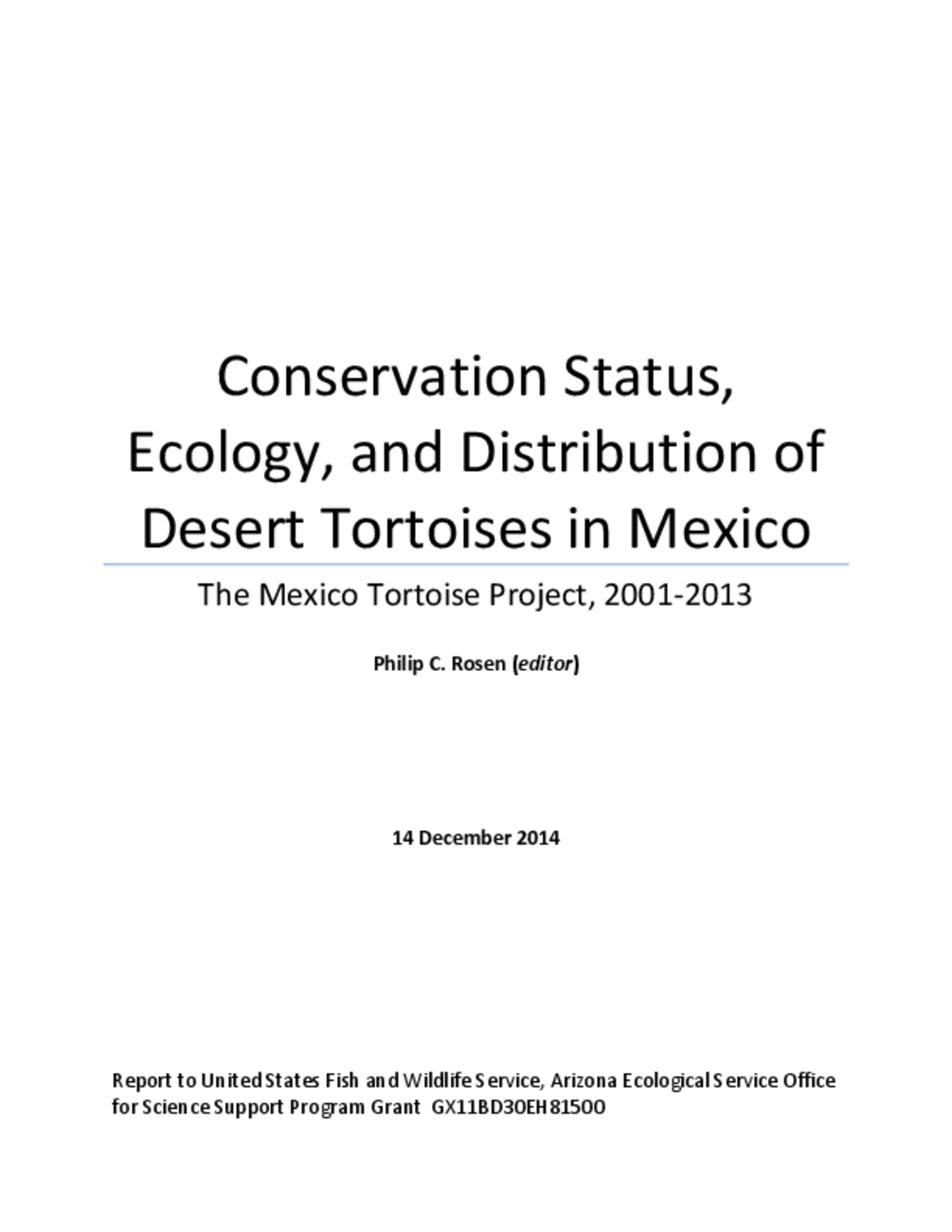Conservation Status, Ecology, and Distribution of Desert Tortoises in Mexico
The Mexico Tortoise Project, 2001-2013
We surveyed 43 localities in Sonora and Sinaloa, Mexico during 2005-2013 to collect information on the status, ecology, and genetics of desert tortoises (Gopherus morafkai). We measured and photographed animals we captured, in addition to collecting samples for genetic and health status studies. We also obtained and digitally georeferenced available records of the species’ distribution from museum databases, published literature, and observations from individuals who supplied us with photo documentation. The distribution of this species in Mexico is composed of two genetic lineages where ancient mitochondrial DNA (mtDNA) haplogroup divergence is concordant geographically with strong population genetics observed in nuclear genes. There is a desert type in subtropical Sonoran Desertscrub and marginal, relatively less mesic thornscrub (the “Sonoran” tortoise, G. morafkai sensu stricto) and a Sinaloan type in tropical deciduous forest (TDF) and tropical thornscrub (the “Sinaloan” tortoise, which is likely to be recognized taxonomically in the near future but currently remains within G. morafkai). However, the distribution of desert tortoises in Mexico is continuous within desertscrub, thornscrub, and TDF in habitat with rock or other hard shelters. There are genetically intermediate areas in parts of the thornscrub, and the speciation process between Sonoran and Sinaloan desert tortoises is more spatially complex than the recently formalized species difference between Sonoran and Mojave (G. agassizii) desert tortoises. About half of the range of G. morafkai in Mexico comprises the undescribed Sinaloan form and a contact zone in which admixture is observed in populations. The distribution of the Sonoran tortoise includes most, if not all rocky environments, and surrounding bajadas often to > 3.5 km from the slopes, from the highly arid Pinacate Biosphere Reserve and Central Gulf Coast subdivision of the Sonoran Desert, east through the Plains of Sonora subdivision and into thornscrub in the foothills and mountain bases below the Sierra Madre Occidental. Its known elevational range is 5–1210 m in Mexico; we have not found it above the desert and thornscrub in semi-desert grasslands or higher elevation environments. The Sinaloan tortoise is abundant in the region of Alamos in rich TDF, which it follows north along the base of the Sierra Madre into east-central Sonora. A recent published record demonstrates that it follows a like corridor also into southwestern Chihuahua. We also found Sinaloan tortoises in thornscrub in northern Sinaloa, where it extends south to at least Topolobampo, and in central-southern Sonora. We found very little evidence of mortality in Sinaloan tortoise populations in TDF in either Sonora or Sinaloa, although this may reflect decomposition of carcasses after predation. In contrast, in thornscrub we found carcasses at several localities, in both

Desert Tortoise in Mexico: Final Report 2014 pg.11
states, including in a high proportion in samples from thornscrub in Sonora. We found evidence of elevated mortality in the northwestern deserts in Sonora in 2012, and previously (2001-02) observed mass mortality and population reduction at study sites in central coastal Sonora. Observed mortality patterns showed an association with drought and the heat of low-elevation environments.
A second major threat to G. morafkai is conversion of native desertscrub and thornscrub to induced buffelgrass pasture in Mexico and the rapid and continuing self-spread of buffelgrass into native vegetation occupied by G. morafkai. As with climate change, this threat is more pronounced in desertscrub and thornscrub than in TDF. Buffelgrass spreads fire into non-fire adapted scrub communities, eliminating shade trees and killing tortoises; it also appears to outcompete preferred plants comprising the diet of G. morafkai, and may thereby degrade the body condition of tortoises, exposing them to further risk associated with climate warming and drying as well as other threats that may arise, such as disease. In TDF, buffelgrass severely degrades the operative thermal environment for desert tortoises, but this grass does not take over the native vegetation, and is quickly replaced by second growth of native species if these are not regularly controlled. Thus, the buffelgrass problem is more severe and less tractable from a conservation management standpoint in desertscrub and thornscrub than in TDF.
Among the several other impacts that might threaten G. morafkai, road mortality is the best known and most likely to increase in severity. Although G. morafkai is still eaten by people in Mexico, this threat has decreased greatly in recent decades. More people use tortoises as pets, by far, than eat them, which may locally deplete some populations. A greater potential threat emanating from the use of desert tortoises as pets is facilitation of disease processes, with introduction of exotic reptile diseases into wild populations of greatest concern, although only as a potential threat. We found G. morafkai abundant at numerous localities in Mexico, and we found it at almost all localities we sampled even though sampling was often brief. Without the threats of climate change and buffelgrass, we would have limited concerns for the future of this species in Mexico or the United States.

